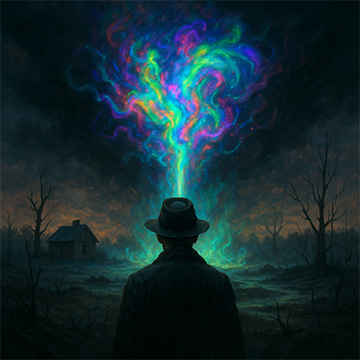I was rewatching HBO’s Chernobyl, a five-part miniseries dramatizing the 1986 nuclear disaster, with my oldest son, who hadn’t seen it yet. If any scenario captures my idea of hell itself belching out of its bindings to vomit suffering on the earth, it’s a broken nuclear core. Last time I watched it, I was outlining sequels to my novella Hood and Fae which involves layers of hell.
This time my son made a different analogy.
“If anything comes closest to H.P. Lovecraft’s ‘eldritch horrors,’” he said, “it has to be radiation.”
“Holy shit, you’re right,” I said. (“Also, I’m going to steal that idea to restart my blog, since it’s been a while since I’ve posted.”)
The first episode captures this uncanny, inhuman sense of a power somehow beyond what humans evolved to comprehend. There’s a haunting scene where the families are watching the open core burn in the distance as it were a terrestrial fire. The air glows as if an extraterrestrial ray were about to beam up victims to a spaceship in orbit. The ash blows over the mothers, father, playing children and babies in their prams, much like ash from the recent Altadena fires recently coated my gardens.
The watchers are not afraid because no human instinct warns us that nuclear fission is far different than ordinary combustion. I feared the ash that landed on my roof might spark a fire, and that was scary enough. But at least it didn’t result in inexplicable vomiting, burns on my face days later, sloughing off skin or insides turning into mush in which even the very cells lost coherence.
The poison of radiation is visceral but unseen; it infects you in a way that feels cosmically unfair. That dread of something invisible, silent, and irreversible is captured perfectly in Lovecraft’s work.
It is a mere coincidence? Perhaps not; consider the dates side by side. Lovecraft was born in 1890. Wilhelm Röntgen discovered X-rays in 1895. In 1898 – Marie and Pierre Curie isolated radium and polonium. Radium, in particular, attracted attention for its strange glowing properties… and its uncanny cruelty to inflict flesh burns without fire.
The Radium Girls scandal occurred in the 1920s-30s. Young women suffered horrific health effects from painting radium dials with grotesque, unexplained symptoms like jaw necrosis and anemia.
The 20s and 30s were also when Lovecraft wrote most of his famous works.
My favorite Lovecraft story is not explicitly part of the more famous Lovecraft Mythos. It’s his short story The Colour Out of Space (1927), a tale often overlooked but perhaps his most haunting.
In it, a meteor crashes on a remote farm in rural New England. From it emanates a strange “colour”—not like any on the visible spectrum, but an otherworldly radiance that seeps into the groundwater, the crops, and the people. The land becomes twisted. Plants grow massive but tasteless and inedible. Animals are born misshapen. The farmers begin to waste away, mentally and physically. The horror is slow, insidious, and utterly implacable. The colour cannot be touched or reasoned with. It cannot be fought. Eventually, the land dies. The colour returns to the sky, leaving a blasted, cursed zone behind—a place no life should ever return to.
To watch Chernobyl is to witness a world unravel to a thing that has no face, no motive, no identity, a glowing cosmic malice that repays both the sins and ignorance of humankind with merciless suffering.
What makes Chernobyl such a powerful series is that it tells a true story with the structure and mood of science fiction horror. The radioactive isotopes released by the reactor—iodine-131, cesium-137, strontium-90—are invisible “colours” from our own space. When plant workers see a strange blue glow rising from the exposed core, it mirrors the alien luminance described by Lovecraft. And like his “colour,” radiation in Chernobyl corrupts both biology and sanity. Victims of acute radiation syndrome swell and burn from the inside. Soldiers descend into superstition. Bureaucrats sacrifice truth for control. It is a madness born not from ignorance, but from unwillingness to acknowledge the scope of what has been unleashed.
There are no monsters in Chernobyl, but there is monstrosity. The series builds tension through silence, countdowns, unanswered phones, and the choking weight of secrecy. The humans in charge don’t know what they’re dealing with, but they pretend they do. That pretense—born of political hubris—is the other great horror. Just as Lovecraft’s protagonists are often ruined by their own curiosity or denial, so too does the Soviet system collapse under the weight of its own lies.
I suppose Hell itself wouldn’t be complete with only Lovecraft; you’d also need a dose of Kafka.

